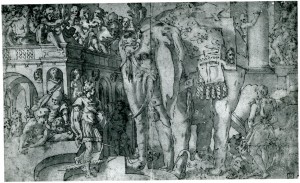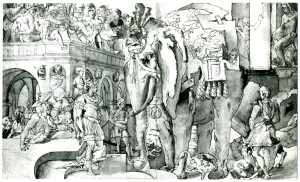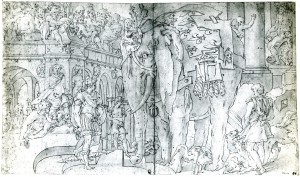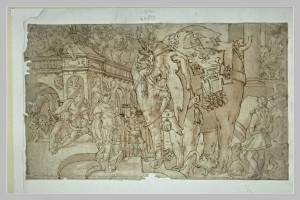For the Fresco in the Gallery of Francis I, Fontainebleau
c. 1531/1532-1534
D.54A. Berlin, Staatliche Museen Preussischer Kulturbesitz, Kunstbibliothek, no. 3398.
Pen and brown ink and brown wash over traces of black chalk, 26.8 x 44.8; laid down; wm?.1 Strong vertical center fold with some of the sheet missing, a tear at the far right from the right shoulder of Pluto to the edge of the sheet, and much faded and/or abraded at the lower right edge.
PROVENANCE: J. Richardson (Lugt 2184 or 2170); Joshua Reynolds (Lugt 2364); Destailleur, no. 107 (Lugt 740; see Berckenhagen, below, and Lugt 740).
LITERATURE:
Kusenberg, 1933, 164, n. 1, as a copy of Rosso’s fresco in the Gallery of Francis I.
Berckenhagen, 1968, 11, 12, Fig. 11, as a copy of Rosso’s fresco and perhaps by Thiry.
Berckenhagen, 1970, 10, 11, as a copy of Rosso’s fresco perhaps by Thiry or Nicolas Belin.
Béguin and Pressouyre, 1972, 136 (wrongly as no. 339B), as a copy of Rosso’s fresco with variations in details.
Wilson-Chevalier, 1982, 6, 14, n. 14, as after Rosso’s fresco.
Carroll, 1987, 264, 267, n. 1, under no. 83.
D.54B. Formerly (in 1959) London, DeBeer’s Fine Arts Ltd.2
Pen and ink and wash, of approximately the same dimensions as the other copies catalogued here. Very much damaged and torn and with a large stain in the center.
LITERATURE:
Carroll, 1987, 264, 267, n. 1, under no. 83.
D.54C. New York, Daniel Wildenstein Collection.
Pen and ink and wash, 28 x 47.6. Creased down the center.
LITERATURE:
Panofsky, 1958, Supplement, b., as a duplicate of the drawing in the Bibliothèque Nationale, Paris (see below).
Béguin and Pressouyre, 1972, 136, as attributed to Rosso in the Wildenstein Collection and as resembling the drawing in the Bibliothèque Nationale and Fantuzzi’s etching.
Terrasse, 1981, 36, n. 2, mentioned.
Wilson-Chevalier, 1982, 6, 14, n. 14, as after Rosso’s fresco.
Carroll, 1987, 264, 267, n. 1, under no. 83.
D.54D. Paris, Bibliothèque Nationale, B. 5 réserve, Dessins de l’École de Fontainebleau, Vol. I, no. 31.
Pen and ink and wash over black chalk, 27.3 x 45.9. Inscribed in ink in the lower right corner: 44. Creased down the center.
PROVENANCE: Société de l’Alliance des Arts, Paris (Lugt 61); Destailleur; Herbet, (D.3159, Lugt 740); another collector’s mark in blue in the lower left corner.
LITERATURE:
Panofsky, 1958, 169-170, n. 42, and Supplement, b., as related to Rosso’s fresco in the Gallery of Francis I, and as a duplicate of the drawing in the Wildenstein Collection (see above).
Berckenhagen, 1968, 11, and Berckenhagen, 1970, 10, as a copy (presumably of Rosso’s fresco).
Béguin and Pressouyre, 1972, 136, as anonymous.
Wilson-Chevalier, 1982, 6, 14, n. 14, as after Rosso’s fresco.
Marianne Grivel, in Ronsard, 1985, 106-107, with Fig., as reproducing the fresco in the Gallery of Francis I.
Carroll, 1987, 264, 267, n. 1, under no. 83.
D.54E. Paris, Ensba, Masson 1197.
Pen and ink and wash over black chalk, 28.4 x 47.2; wm. Creased down the center. Inscribed in ink with a monogram on the riser of the upper step at the lower left, and: 1620 on the riser of the lower step.
PROVENANCE: Jean Masson (Lugt 1494a); another collector’s mark in the lower right corner.
LITERATURE:
Masson, 1927, 24, no. 124, as anonymous, sixteenth century, and as related, with variations, to Rosso’s fresco in the gallery of Francis I.
Kusenberg, 1931, 150, no. 27, as a copy of Rosso’s fresco.
Béguin and Pressouyre, 1972, 136, as anonymous.
Wilson-Chevalier, 1982, 6, 14, n. 14, as after Rosso’s fresco.
Carroll, 1987, 264, 267, n. 1, under no. 83.
D.54F. Paris, Louvre, Inv. 1598.
Pen and ink and wash over black chalk, 27.8 x 46.7; laid down; wm?. Small parts missing from the sheet along the left edge and at the bottom, rubbed at left and right sides, and creased down the middle and along the bottom.
LITERATURE:
Kusenberg, 1931, 150, no. 21, as a copy of Rosso’s composition at Fontainebleau.
Barocchi, 1950, 134, as a copy of Rosso’s fresco.
Berckenhagen, 1968, 11, n. 9, and Berckenhagen, 1970, 10, as a copy (presumably of Rosso’s fresco).
Béguin and Pressouyre, 1972, 136, Fig. 201, as anonymous.
Wilson-Chevalier, 1982, 6, 14, n. 14, as after Rosso’s fresco.
Carroll, 1987, 264, 267, n. 1, under no. 83.
Scailliérez, 1992, 132, no. 57A, 133, Fig. A, as a copy of Rosso’s composition possibly from a lost original drawing, and perhaps preparatory to Fantuzzi’s etching.
These six drawings, all of the same size, are discussed as copies of a single lost drawing by Rosso for his fresco of The Royal Elephant in the Gallery of Francis I in P.22, VI N, and in Chapter VIII. It is, however, possible that some, and perhaps all, of them go back to a lost copy, and some of these surviving copies could copy each other. The best version seems to be that in the Wildenstein Collection.
All the drawings show exactly the same composition, which, however, differs from the fresco in several details. The primary difference is the appearance of the elephant, which in the drawings has a larger head, far longer ears, and a trunk that curves away from the body, not towards it. The strap across the animal’s chest is different and from it hangs a bell (?). Its left foot is more forward and the posture of the crane is not the same. The fleur-de-lis on the elephant’s cover is different, as are Cerberus’s heads. At the upper left the woman is nude. The penmanship of all the copies clearly copies Rosso’s as we know it from such original drawings as the Throne of Solomon (Fig.D.34), the Pandora and Her Box (Fig.D.67a), and the Petrarch drawing at Christ Church (Fig.D.47a). It is probable that the penmanship of the lost drawing was most similar to that of the Petrarch drawing, rather than to the rapid and somewhat gnarled handling of the Pandora. Where the copies most differ graphically is in the strength and disposition of the washes. The Berlin drawing shows them clearest, but they are all of one value. The three drawings in Paris (I do not remember the specific appearance of the copy formerly in London) have paler but also single-toned washes disposed more or less as in the Berlin copy. However, in the Wildenstein copy, at least three tones of washes appear and although some of them seem rather arbitrarily placed, especially the darkest ones, their employment recalls the use of various tones of wash in Rosso’s Throne of Solomon and in the Pandora drawing. The Petrarch drawing and the Annunciation in the Albertina (Fig.D.43a) show at least two tones of dark wash to supplement the dark tonality established by the dark washed paper on which they are executed. The Wildenstein copy would seem to indicate something of the tonal range of Rosso’s lost drawing that is missing from the other copies. In the brush strokes of the wash on the ear of the elephant, the Wildenstein drawing may also show something even more specific of the handling of Rosso’s lost drawing, similar to the shading on the body of the central figure in the Pandora drawing.
However, the absence of this detail in all the other copies – although it may appear slightly in the Ensba drawing – makes its appearance in the Wildenstein drawing subject to wondering what this kind of shading represents of the original. For if it reflects the application of a dark wash, there is no reason why it should not show up in the other drawings, unless they all copy one lost copy that did not show these strokes because of an oversight of the first copyist. However, it is very likely that what these strokes, or more exactly the areas between them, represent is an attempt to indicate the application of white highlights on a dark wash or dark washed ground, such as appears in the Albertina Annunciation and the Petrarch drawing. If this is true, it would mean that Rosso’s lost drawing was done with pen and ink and washes, heightened with white, on a dark ground as was the lost original of his drawing for the early version of the Scene of Sacrifice (Fig.D.50B). The somewhat unsuccessful use of dark washes in all the copies further suggests that they are all translations into a simpler mode of the original drawing that was technically and in its effects richer and more complex.
As the Royal Elephant composition would seem to be from the early phase of Rosso’s activity on the designs for the gallery, done between c.1531/1532 and 1534, when the stuccoers began to work in the gallery, the lost drawing for this scene must have been done within this period (see P.22).
PRINT: Fantuzzi, E.65 (Fig.E.65). Etching derived from Rosso’s original drawing or from a copy of it.





